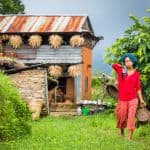A Tale of Two Islands: Solar Helps Indian Resort Shine
Much of the debate on the move to solar energy has focused on its positive environmental impact, and it’s a valid argument when evaluating solar or other renewable energy options as replacement to existing fossil fuel solutions. But solar has other less-talked-about benefits, such as providing energy where no access exists to conventional power, as we have seen in the case of mini-grids powering India’s villages. And, as I found out on a recent trip to Lakshadweep, it can provide a much-needed boost to an island economy where tourism is the only industry and the availability of energy and the resultant comforts can be the difference between an obscure, largely uninhabited place and a thriving economy.
Lakshadweep is India’s tiniest union territory. Set several hundred miles away from the mainland, this group of 36 islands in the Indian Ocean has been built by corals. Some of the islands have villages, a larger number are uninhabited, but all of them boast unparalleled natural beauty with clear turquoise waters and white sand beaches. Yet Lakshadweep barely registers on any tourist map.
Part of Lakshadweep’s obscurity is intentional. The corals are ecologically sensitive, resources are scarce and all supplies, including energy (where it’s diesel generated), have to come from the mainland. There are tourist resorts on five of the islands and all of these are run by the government. Given the limited accommodations, visitors – even those coming from India – require a permit to enter the islands.
Bringing more divers and tourists to Lakshadweep, in an ecologically responsible way, is the most logical way to ensure economic growth of the local population. As Lakshadweep’s Society for Promotion of Nature Tourism and Sports embarks on its mission to promote tourism on the islands, the availability of resources will be key. And as I found out on my recent visit, the choice of energy sources makes all the difference.
My first point of call was Kadmat. This is one of the larger islands, with a village of 5,000-odd residents, a college and even a coconut-processing plant. At the entrance to the Kadmat resort sits a 260-kilowatt solar power plant. Kadmat is the only island resort with air conditioning in its cottages, a benefit you come to appreciate quickly in the 40-degree Celsius (104 Fahrenheit) summer heat. Most islands in Lakshadweep offer fantastic diving sites, and in Kadmat you come back from your dives to ice-cold drinks and cool showers. It may not be luxurious but it’s a great prelude to a sunset and a dinner on the beach. It’s a resort that travelers will return to for water sports and lazy beach holidays.
After three days in Kadmat, I decided to pay a visit to Thinnakara, a tiny teardrop-shaped island that, believe it or not, has even prettier beaches. With hammocks spread all over the white sand, Thinnakara is the very definition of a tropical paradise. Yet the first thing that greeted us on arrival was the information that the island was low on diesel and, hence, power was not available from noon to about 3 p.m. This was January, not even summer, but those were clearly not a very comfortable three hours. Even when the power supply was switched back on, the slow-moving fans provided little relief from the heat. There clearly isn’t enough energy supply to run a water purification plant in Thinnakara, which means that the well water getting pumped to the rooms has an unpleasant smell. All in all, not an experience that will bring in tourists to kickstart Thinnakara’s economy, or that of the neighbouring Bangaram – a larger but equally energy-starved island.
There is no doubt in my mind that Kadmat’s success is attributed in no small measure to the solar plant that provides all the comforts travelers have come to expect. I was told that there are plans to expand the solar footprint to other islands in Lakshadweep. In a recent tender, the Solar Energy Corporation of India even offered subsidies for setting up rooftop solar plants on the islands. That may just be the impetus Bangaram and Thinnakara need to put them on tourists’ must-visit lists.
Simmi Sareen is the founder of Loans4SME, a marketplace to catalyze cash-flow based loans for small businesses in India.
Photos courtesy of the author
- Categories
- Energy, Environment



